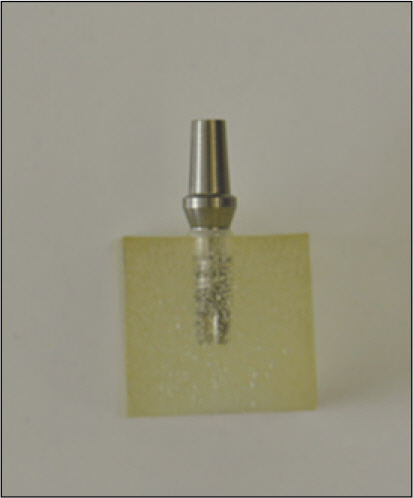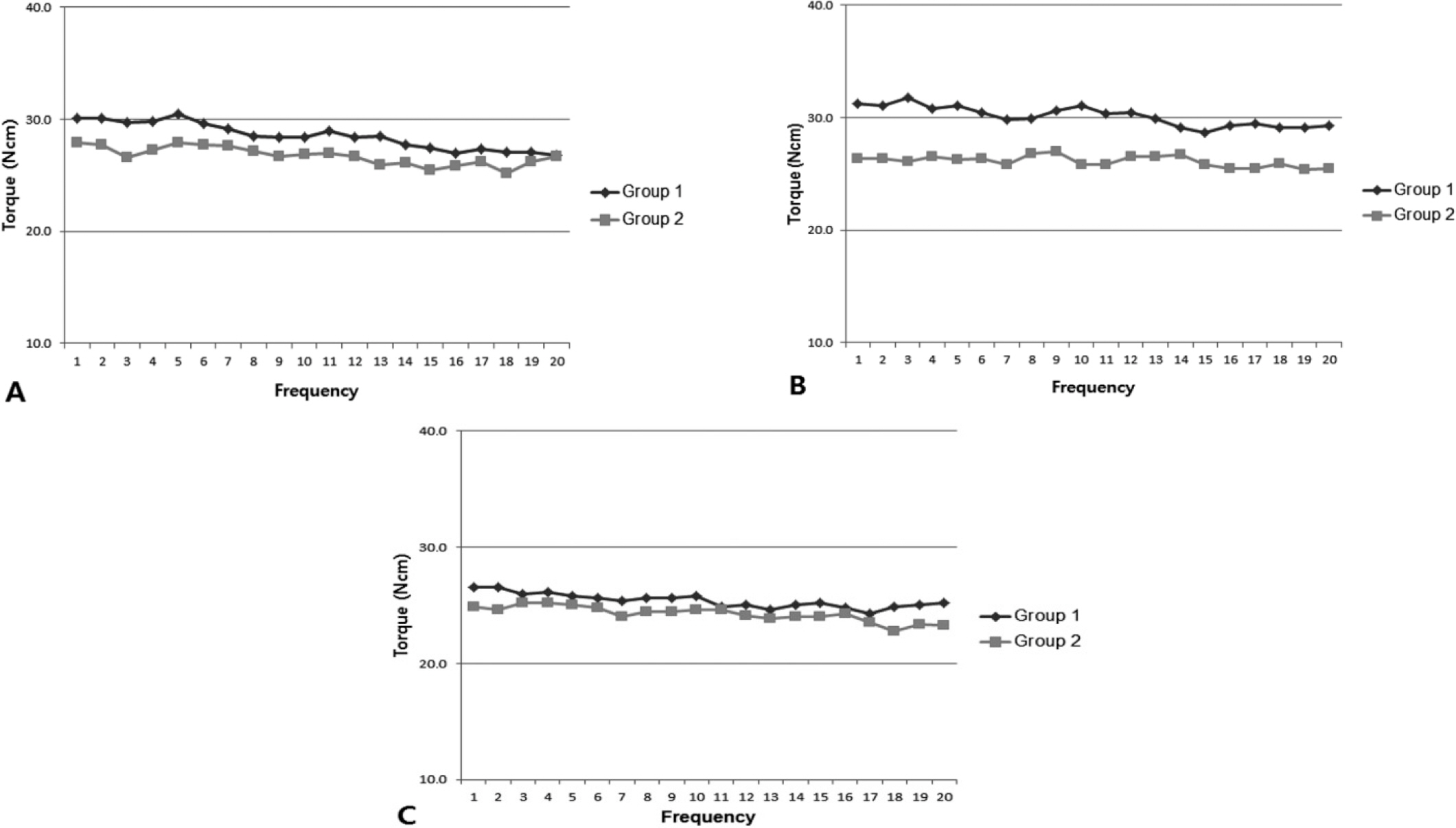J Korean Acad Prosthodont.
2013 Oct;51(4):300-306. 10.4047/jkap.2013.51.4.300.
Comparative analysis of accuracy of how to use the implant torque controllers
- Affiliations
-
- 1Department of Prosthodontics, College of Dentistry, Gangneung-Wonju National University, Gangneung, Korea. muscleman@gwnu.ac.kr
- 2Department of Prosthodontics, Sanbon Dental Hospital, Wonkwang University, Gunpo, Korea.
- 3Department of Dentistry, Uijeongbu St. Mary's Hospital, Catholic University of Korea, Uijeongbu, Korea.
- KMID: 2000154
- DOI: http://doi.org/10.4047/jkap.2013.51.4.300
Abstract
- PURPOSE
This study was to evaluate the accuracy of how to use the Mechanical Torque-Limiting Devices.
MATERIALS AND METHODS
Three different implant manufacturers (Dentium, Osstem, Shinhung) were prepared for each two implant torque controllers. Divided into two groups depending on the method used for removal torque was measured. Repeated measures of ANOVA test (alpha=.05) was used as statistics to evaluate the effect of repeated loading number on the removal torque. Independent t-test was used to evaluate the difference in removal torque of two groups.
RESULTS
The removal torque significantly decreased as the number of loading repetition increased (P<.05). There was significant difference between two groups.
CONCLUSION
Loosen the handle part of the implant torque controllers spring resilience to recover one group compared to the group that did not, showed a little more closed to the reference value.
Keyword
MeSH Terms
Figure
Cited by 1 articles
-
Accuracy of spring-style and friction-style mechanical implant torque wrench
Dong-Hee Cha, Sang-Chun Oh
J Korean Acad Prosthodont. 2016;54(1):8-13. doi: 10.4047/jkap.2016.54.1.8.
Reference
-
1.Jaarda MJ., Razzoog ME., Gratton DG. Ultimate tensile strength of five interchangeable prosthetic retaining screws. Implant Dent. 1996. 5:16–9.
Article2.Jaarda MJ., Razzoog ME., Gratton DG. Comparison of "look-alike" implant prosthetic retaining screws. J Prosthodont. 1995. 4:23–7.
Article3.Jaarda MJ., Razzoog ME., Gratton DG. Geometric comparison of five interchangeable implant prosthetic retaining screws. J Prosthet Dent. 1995. 74:373–9.
Article4.Mitrani R., Nicholls JI., Phillips KM., Ma T. Accuracy of electronic implant torque controllers following time in clinical service. Int J Oral Maxillofac Implants. 2001. 16:394–9.5.Standlee JP., Caputo AA., Chwu MY., Sun TT. Accuracy of mechanical torque-limiting devices for implants. Int J Oral Maxillofac Implants. 2002. 17:220–4.6.Vallee MC., Conrad HJ., Basu S., Seong WJ. Accuracy of friction-style and spring-style mechanical torque limiting devices for dental implants. J Prosthet Dent. 2008. 100:86–92.
Article7.Tan KB., Nicholls JI. The effect of 3 torque delivery systems on gold screw preload at the gold cylinder-abutment screw joint. Int J Oral Maxillofac Implants. 2002. 17:175–83.8.Dellinges MA., Tebrock OC. A measurement of torque values obtained with hand-held drivers in a simulated clinical setting. J Prosthodont. 1993. 2:212–4.
Article9.Gross M., Kozak D., Laufer BZ., Weiss EI. Manual closing torque in five implant abutment systems: an in vitro comparative study. J Prosthet Dent. 1999. 81:574–8.
Article10.Dellinges M., Curtis D. Effects of infection control procedures on the accuracy of a new mechanical torque wrench system for implant restorations. J Prosthet Dent. 1996. 75:93–8.
Article11.Saboury A., Sadr SJ., Fayaz A., Mahshid M. The effect of aging on the accuracy of new friction-style mechanical torque limiting devices for dental implants. J Dent. 2013. 10:41–50.12.McCracken MS., Mitchell L., Hegde R., Mavalli MD. Variability of mechanical torque-limiting devices in clinical service at a US dental school. J Prosthodont. 2010. 19:20–4.
Article13.Standlee JP., Caputo AA. Accuracy of an electric torque-limiting device for implants. Int J Oral Maxillofac Implants. 1999. 14:278–81.14.Gutierrez J., Nicholls JI., Libman WJ., Butson TJ. Accuracy of the implant torque wrench following time in clinical service. Int J Prosthodont. 1997. 10:562–7.15.Binon PP. Evaluation of the effectiveness of a technique to prevent screw loosening. J Prosthet Dent. 1998. 79:430–2.
Article16.Siamos G., Winkler S., Boberick KG. Relationship between implant preload and screw loosening on implant-supported prostheses. J Oral Implantol. 2002. 28:67–73.
- Full Text Links
- Actions
-
Cited
- CITED
-
- Close
- Share
- Similar articles
-
- Accuracy of spring-style and friction-style mechanical implant torque wrench
- Accuracy of different electronic torque drivers: A comparative evaluation
- A study on accuracy and application of the implant torque controller used in dental clinic
- Evaluation of fitness in implant screw as tightening torque in dental laboratory
- Torque and mechanical failure of orthodontic micro-implant influenced by implant design parameters








